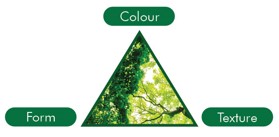Garden Focus - Apr/May 2022
The power of triangles in landscape design
The power of triangles in landscape design
he three main principles of landscaping design – colour, texture and form – can be enhanced by combining plants with similar traits in a triangular pattern. Depending on the theme and scale of the design, you can create a mass effect with either flower or foliage colour, texture, or shape. Plant species can be varied within the triangle, as long as they share one of these three features. The various plants sharing the same traits create harmony and make for an interesting and diverse garden. A greater depth perception can also be created by simply spacing the plants further apart.

Placing plants in triangular patterns not only creates a depth perception, but the rule of three is also a standard one when grouping plants in a flower bed or container. Triangular patterns add a perception of fullness and depth. Square groupings, on the other hand, do not offer that depth, leaving you with visual gaps in between your plants.
Designers like using triangles to lead the eye toward a certain direction and similarly, in hard landscaping, triangular stone shapes or interlocks or simply the shape of the lawn may be used to draw our eyes to a specific focal point.
Normally plant beds are rectangular, but a triangle shape could be the tweak you need to bring about change in your garden. Most yards have corners or angles where one could incorporate an interesting triangular bed, whether the triangle is equilateral, isosceles, scalene, or right angled – refresh your memory on trigonometry before opting for a triangular bed.
When selecting which plants to group together, remember to consider their need for sunlight and water. For all species to thrive equally in their triangular bed, they would need to have similar dietary needs.
Planting tall plants around the triangle’s edge will obscure plants in the centre, blocking off sunlight. Instead, place tall plants along the edge of the triangle, and plant varieties of gradually decreasing mature heights as you plant farther from the edge. Alternatively, place tall plants in the triangle’s centre, and surround them with progressively shorter plants. This will give a pyramid effect and have a further interesting triangular appearance as your garden progressively grows towards maturity.
Whether vertical or horizontal, the triangle of your choice will be a strong and solid feature in your landscaping. So much more can be added to it with the three pillars of garden design – colour, texture and form – giving you endless scope to play around with in your imagination.
We have a rich selection of plant material in our nursery, bound to reward your creative ideas. Be bold and differentiate your garden design with triangles.

Eugene le Roux

AgriTurf: Marco de Wet
Cell: 081 600 9584

Pupkewitz Megabuild:
Eugene le Roux
Horticulturist
Cell: 081 124 6965

